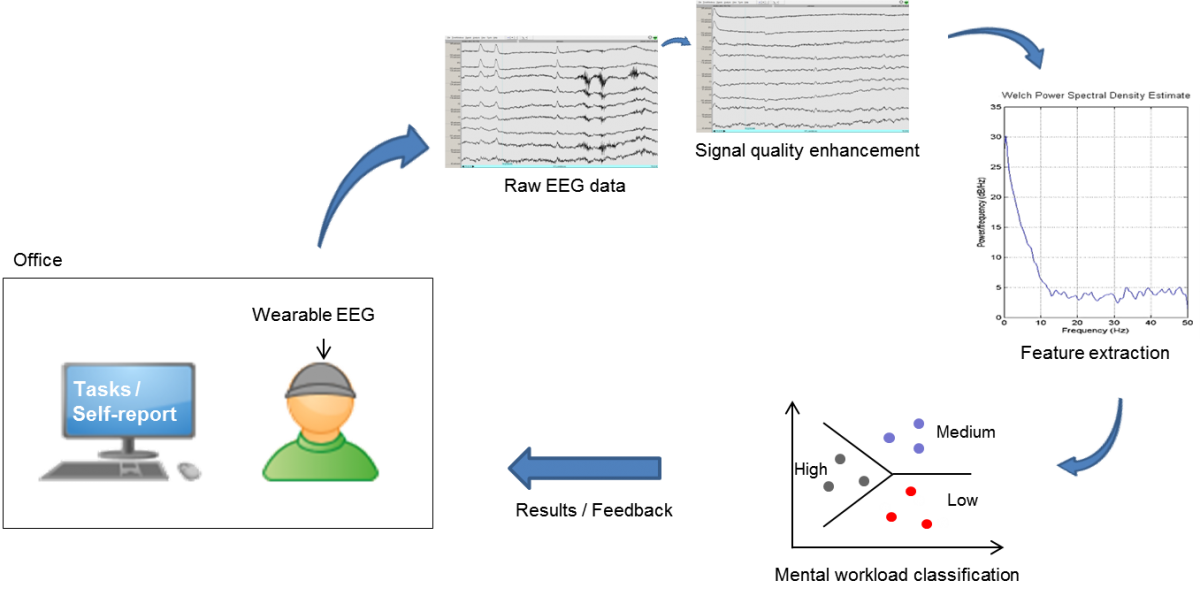Wearable long-term brain monitoring
11 July 2011
Abstract of the Project
The electrical activity of the brain can be monitored by electroencephalogram (EEG) systems. Conventional systems comprise cumbersome clinically or laboratory- oriented equipment to which the subject is tethered with cables and gel-based electrodes under well-controlled environments and conditions. Recent technological advances have led to wearable EEG systems [1], which allow wireless data transmission, improve end-user acceptance, reduce preparation and set-up time and enable long-term measurements. Consequently, wearable EEG systems are the enabling technology for real life applications in out-of-the-lab scenarios.
Among the wide range of possible applications, mental workload assessment is a promising candidate [2, 3]. The significance of mental workload in our lives has been acknowledged by various disciplines, like neuroergonomics [4]and human-machine systems [5]. Sustained high levels of mental workload increase the risk of human errors and may result in work-related stress, depression and even occupational burn-out, effects which in turn result in immense societal and economic costs [6-9].
Goals
In this project our focus is on office-related tasks. After defining the wearable EEG system requirements for such studies, we identified the most suitable one among the readily-available commercial systems. Our next steps are to check the technical feasibility of unobtrusive and continuous brain monitoring in the office-related settings and to study whether the assessment of mental workload under these settings is possible for a given person. In order to achieve this, we adopt the approach illustrated in Fig.1. The definedsubject group will perform mental tasks, similar to the ones found in literature [2, 10]and fill in questionnaires for the perceived workload [11]while their brain activity will be recorded with the chosen wearable EEG system [12]. Inspired and supported by existing tools for EEG processing [13], we will explore various techniques for workload assessment with brain monitoring, using the self-reported questionnaires and the difficulty level of the tasks as reference (see Fig. 2).
The outcomes of the project at hand will contribute to our knowledge on the feasibility of brain activity monitoring by wearable EEG-systems in more realistic settings. Furthermore, we will establish a clear view on whether mental workload assessment is possible under these more realistic conditions.
Research Achievements to date:
- The study plan to evaluate the feasibility of wearable EEG recordings in the context of work-related mental load has been formulated.
- A survey of the state-of-the-art regarding wearable brain activity monitoring has been finalized and a system that fulfills our study requirements has been obtained.
- The following presentation have taken place:
- “Workload-meter”, 6th ScienceSLAM Helsinki, 15.11.2012
- “EEG and assessment of workload”, Helsinki Summer School, 08.08.2012
- "Wearable EEG monitoring to estimate workload", Doctoral Consortium, ISWC 2012, 18.06.2012
- “Current Trends on the Applications of Wearable Health Monitoring Systems on Mental Health”, 8th Annual Mini Conference on Scientific Publishing, Tampere University of Technology (TUT), 24.02.2012
- Program Committee for the International Workshop on Extending Seamlessly to Internet of Things (esIoT 2012).

Figure 1. Conceptual illustration of the proposed approach

Figure 2. A conceptual illustration of the signal processing methodology
References
[1] Lun-De Liao, Chin-Teng Lin, K. McDowell, A. E. Wickenden, K. Gramann, Tzyy-Ping Jung, Li-Wei Ko and Jyh-Yeong Chang. Biosensor technologies for augmented BrainñComputer interfaces in the next decades. Proceedings of the IEEE 100(Special Centennial Issue), pp. 1553-1566. 2012.
Personal Webpage: http://www.icarenet.eu/fellows/Evangelia
Collaborations:
- ACTLab, TUE Eindhoven
- Charité University Medical Center Berlin

